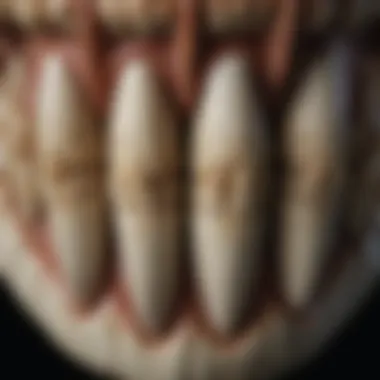Unveiling the Enigmatic World of Genuine Alligator Teeth


Introduction
Real alligator teeth are enigmatic natural artifacts that hold a profound significance across various cultures and societies. In this detailed exploration, we will unravel the mysteries surrounding these unique teeth, from their origins in the natural world to their diverse applications in human culture.
Characteristics of Alligator Teeth
Alligator teeth are characterized by their conical shape, sharp edges, and serrations that vary between species. Their composition and structure play a vital role in defining their strength, durability, and adaptation for hunting and defense. Understanding these distinct features is crucial in appreciating the true essence of alligator teeth.
Significance in Culture
The cultural significance of alligator teeth spans a wide spectrum, from symbolizing power and strength in ancient civilizations to serving as decorative elements in modern fashion and accessories. Their presence in rituals, art, and folklore underscores the timeless allure and reverence associated with these remarkable teeth.
Ecological Role of Alligator Teeth
In nature, alligator teeth serve as essential tools for hunting, defense, and territorial display. The evolutionary adaptations that have shaped the teeth of these apex predators highlight their critical role in maintaining ecosystem balance and ensuring the survival of the species over millennia.
Utilitarian Applications
Beyond their symbolic and ecological importance, alligator teeth have found practical uses in various industries, such as crafting traditional weapons, jewelry, and ceremonial ornaments. The versatility of these teeth in different cultural contexts speaks to their enduring value and craftsmanship.
Conclusion
Through this comprehensive exploration of real alligator teeth, we have unveiled the multifaceted dimensions of these fascinating natural wonders. From their role in cultural rituals to their ecological significance, each tooth embodies a rich history and legacy that continues to intrigue and inspire curiosity among enthusiasts and scholars alike.
Introduction to Real Alligator Teeth
Welcome to the captivating realm of real alligator teeth, where the allure of these natural artifacts transcends mere aesthetics. In this article, we will delve into the unique characteristics, significance, and potential applications of these fascinating teeth. As we unravel the mysteries behind these extraordinary teeth, we aim to provide a comprehensive guide for rock and fossil collectors and enthusiasts intrigued by the natural world.
Understanding Alligator Teeth Composition
Enamel
Exploring the composition of alligator teeth, one cannot overlook the remarkable qualities of enamel. Enamel, the outermost layer, plays a crucial role in protecting the tooth from wear and tear during the alligator's lifetime. Its exceptional hardness and resistance make it a popular choice for scientific studies and collectors alike. The unique feature of enamel lies in its ability to withstand the pressure exerted during hunting and feeding, highlighting its importance in the alligator's ecological niche.
Dentine
Moving inward, dentine constitutes the bulk of the alligator tooth structure. Dentine provides support to the enamel and pulp, contributing to the overall strength of the tooth. Its composition offers a balance between durability and flexibility, making it an ideal choice for various research purposes. The distinguished feature of dentine lies in its capacity to endure the forces involved in the alligator's feeding behaviors, showcasing the evolutionary adaptations that have honed this tooth composition over millions of years.
Pulp


The innermost layer, pulp, harbors the blood vessels and nerves essential for the tooth's growth and upkeep. This intricate network within the pulp ensures the vitality of the tooth, aiding in its development and maintenance over time. While often overlooked, the pulp plays a significant role in understanding the biological processes that govern tooth formation in alligators. Its unique feature lies in the relationships it fosters with surrounding tissues, contributing to the tooth's overall integrity and functionality.
Growth and Replacement Cycle
Formation Process
The formation process of alligator teeth is a fascinating journey that begins even before the tooth emerges from the jaw. From initial mineralization to structural development, each stage contributes to the eventual functionality of the tooth. Understanding the intricacies of this process sheds light on the evolutionary adaptations that have shaped alligator teeth over centuries. The formation process showcases nature's precise mechanisms at work, highlighting the efficiency and complexity of tooth development in these majestic creatures.
Shedding and Regeneration
Alligator tooth shedding and regeneration are natural phenomena that ensure the continual maintenance of the dental apparatus. As teeth wear down or sustain damage, the shedding process initiates, paving the way for new teeth to surface. This cycle of renewal underscores the resilience and adaptability of alligator teeth, emphasizing their role in the alligator's survival. The shedding and regeneration process exemplify nature's sustainable approach to dental health, presenting a model of efficiency and resourcefulness within the biological realm.
Physical Characteristics and Adaptations
Shape and Size
The distinctive shape and size of alligator teeth speak volumes about their functional adaptations. With conical, serrated structures, these teeth are finely tuned for gripping and tearing prey, showcasing the precision of evolution in crafting specialized tools for survival. The unique feature of their shape and size lies in their versatility, allowing alligators to efficiently capture and consume a diverse range of prey items. This adaptability underscores the remarkable design of alligator teeth, exemplifying the harmony between form and function in the natural world.
Functionality in Hunting and Defense
Beyond their physical appearance, the functionality of alligator teeth in hunting and defense is a testament to their evolutionary significance. From seizing prey to warding off threats, these teeth play a vital role in the alligator's predatory tactics. Their exceptional strength and sharpness enable precise handling of food items and deterrence of potential rivals, showcasing the multifaceted utility of these natural weapons. The unique feature of their functionality lies in their seamless integration into the alligator's behavioral repertoire, highlighting the strategic advantages conferred by these specialized dental structures.
Cultural and Symbolic Significance
Exploring the cultural and symbolic significance of real alligator teeth provides a profound insight into the deep-rooted connections between nature and human perception. These unique alligator teeth hold a complex history intertwined with symbolism and mythical connotations that span across civilizations. A closer examination reveals how these teeth have been cherished for their symbolic representations in various cultural practices and beliefs for centuries.
Historical Context and Mythology
Alligator Symbolism
Diving into the realm of alligator symbolism uncovers a multifaceted representation of primal power and resilience. The alligator, symbolizing strength and survival, has been a ubiquitous motif in ancient folklore and modern narratives alike. Its symbolic presence resonates with themes of protection, adaptability, and tenacity, making it a compelling choice for emblematic storytelling within the context of real alligator teeth.
Cultural Beliefs
Exploring the cultural beliefs surrounding alligator teeth unveils a tapestry of tradition and reverence. Across different cultures, alligator teeth have symbolized varying concepts like prowess, wisdom, and even spiritual guardianship. Understanding these cultural nuances offers profound insights into the diverse perspectives that elevate the cultural and symbolic significance of real alligator teeth.
Utilization in Art and Jewelry
Traditional Crafts


The incorporation of alligator teeth in traditional crafts exemplifies a harmonious blend of artistry and cultural heritage. From intricate carvings to ceremonial adornments, traditional crafts showcase the meticulous craftsmanship dedicated to preserving the essence of alligator teeth in art. This timeless tradition not only celebrates the natural beauty of these teeth but also serves as a cultural emblem honoring the alligator's significance.
Modern Designs
In contemporary jewelry and artistic expression, alligator teeth find a revived relevance in modern designs. The fusion of alligator teeth with innovative materials and techniques yields captivating creations that bridge the past with the present. Modern designs infuse a fresh perspective into the aesthetics of alligator teeth, appealing to a dynamic audience while retaining the essence of tradition.
Spiritual and Ritualistic Practices
Ceremonial Use
Within spiritual and ritualistic contexts, the ceremonial use of alligator teeth embodies sacred rituals and ceremonial rites. These teeth, revered for their symbolic potency, play integral roles in ceremonies symbolizing protection, strength, and spiritual guidance. The ceremonial incorporation of alligator teeth reflects a deeply rooted tradition that resonates with spiritual seekers and practitioners alike.
Symbolic Meanings
Exploring the symbolic meanings associated with alligator teeth unveils a rich tapestry of interpretations and spiritual significances. From symbols of courage to representations of transformation, the symbolic meanings attributed to alligator teeth transcend cultural boundaries. Delving into these interpretations offers a profound glimpse into the mystical and symbolic realm that alligator teeth inhabit, enriching spiritual practices and belief systems.
Practical Applications and Conservation Efforts
Real alligator teeth, fascinating natural artifacts, offer remarkable practical applications and conservation value. These teeth, renowned for their unique characteristics and cultural significance, play a vital role in various industries and conservation efforts. In the realm of practical applications, the utilization of alligator teeth spans from traditional crafts to modern designs, showcasing their versatility and aesthetic appeal. Conservation efforts focused on these teeth are crucial for preserving alligator populations and maintaining ecological balance, making them a significant subject of discussion in this article.
Commercial Uses and Trade
Market Demand
The market demand for real alligator teeth is a compelling aspect within the broader scope of alligator trade. This demand is fueled by various factors, including their rareness, aesthetic qualities, and historical value. Alligator teeth are sought after by collectors, artisans, and enthusiasts alike, leading to a thriving market that caters to diverse consumer preferences. The unique feature of market demand lies in the exclusivity and desirability surrounding real alligator teeth, making them a coveted choice in the realm of exotic natural artifacts. While the high demand presents lucrative opportunities, it also raises concerns related to sustainable sourcing and ethical considerations, a critical dynamic intertwined with the market for alligator teeth.
Regulatory Measures
Regulatory measures governing the trade of alligator teeth are pivotal for ensuring sustainability and ethical practices within the industry. These measures encompass laws and guidelines that oversee the harvesting, sale, and international trade of alligator teeth, aiming to prevent illegal wildlife exploitation and protect endangered species. The key characteristic of regulatory measures lies in their role in promoting responsible trade practices, fostering conservation efforts, and safeguarding alligator populations from overexploitation. While regulatory measures provide essential safeguards, they also pose challenges in enforcement, compliance, and global coordination, reflecting the complex landscape of regulations governing the trade of real alligator teeth.
Conservation Challenges
Threats to Alligator Populations
The conservation challenges facing alligator populations stem from various threats, including habitat loss, human-wildlife conflict, and illegal harvesting. These threats jeopardize the sustainability of alligator populations, raising concerns about biodiversity loss and ecosystem degradation. The key characteristic of threats to alligator populations is their multifaceted nature, necessitating comprehensive conservation strategies to address underlying issues and mitigate risk factors effectively. While efforts are being made to tackle these threats, ongoing vigilance and conservation initiatives are essential to safeguard the long-term viability of alligator populations in their natural habitats.
Legal Protection Initiatives
Legal protection initiatives serve as a crucial tool in mitigating conservation challenges and ensuring the welfare of alligator populations. These initiatives encompass legislation, international agreements, and conservation programs aimed at combating illegal trade, preserving habitats, and promoting sustainable practices. The key characteristic of legal protection initiatives is their role in establishing frameworks for wildlife protection, enforcement mechanisms, and collaborative partnerships across stakeholders. While such initiatives mark significant progress, continuous evaluation, adaptation, and public awareness are vital for enhancing the effectiveness of legal measures in conserving alligator populations and their habitats.


Ethical Considerations in Collection and Sale
Sustainable Sourcing Practices
Sustainable sourcing practices play a fundamental role in ethical considerations surrounding the collection and sale of alligator teeth. These practices entail responsible sourcing methods, traceability mechanisms, and ecosystem-friendly approaches that prioritize conservation and community engagement. The key characteristic of sustainable sourcing practices is their emphasis on promoting transparency, environmental stewardship, and ethical standards throughout the supply chain. While sustainable practices offer environmental benefits and social gains, challenges such as resource constraints, economic viability, and market competitiveness underscore the need for continuous improvement and stakeholder collaboration in shaping sustainable sourcing norms.
Ethical Trade Standards
Ethical trade standards form the ethical framework guiding the responsible trade of alligator teeth, emphasizing principles of fairness, integrity, and respect for wildlife welfare. These standards encompass ethical sourcing, fair trade practices, and compliance with international guidelines on wildlife trade. The key characteristic of ethical trade standards lies in their commitment to upholding ethical principles, supporting conservation efforts, and enhancing stakeholder trust in the ethical sourcing of alligator teeth. While ethical standards set a benchmark for ethical behavior, challenges such as enforcement gaps, certification complexity, and market demand dynamics highlight the importance of continuous ethical reflection, industry collaboration, and consumer awareness in promoting ethical trade practices for alligator teeth.
Exploring Alligator Teeth in Modern Context
In this section, we delve into the contemporary relevance of alligator teeth, shedding light on how these natural wonders intersect with modern science, education, and leisure pursuits. By exploring the practical applications and recent discoveries, we aim to showcase the continued value of alligator teeth beyond their historical and cultural significance.
Scientific Research and Discoveries
Biomimicry Studies
Biomimicry studies involving alligator teeth have garnered significant attention for their potential in inspiring innovative engineering solutions. The unique structure and composition of alligator teeth serve as a natural model for developing ultra-strong materials and self-sharpening tools. Incorporating insights from alligator teeth into biomimetic designs can lead to advancements in fields such as dentistry, material science, and aerospace engineering. While biomimicry studies offer promising prospects for enhancing technology, researchers must navigate ethical considerations surrounding the sustainable sourcing of alligator teeth for scientific purposes.
Medical Applications
Alligator teeth have shown promise in various medical applications, particularly in the development of bio-inspired materials for surgical procedures and biodegradable implants. The antimicrobial properties of alligator teeth enamel have sparked interest in creating infection-resistant coatings for medical devices. By studying the regenerative capabilities of alligator teeth, scientists are exploring novel approaches to tissue engineering and drug delivery systems. However, challenges exist in scaling up these applications due to the limited availability of ethically sourced alligator teeth and the need for comprehensive safety assessments in medical settings.
Educational Value and Outreach Programs
In this section, we highlight the educational significance of alligator teeth in fostering scientific curiosity and environmental awareness. Through engaging STEM initiatives and wildlife conservation education programs, individuals of all ages can gain valuable insights into the natural world and the importance of biodiversity preservation.
STEM Initiatives
STEM initiatives focusing on alligator teeth offer students a hands-on opportunity to explore principles of biology, chemistry, and materials science. By examining the structural adaptations of alligator teeth, learners can deepen their understanding of evolution and bio-inspired design. These initiatives not only stimulate interest in STEM fields but also encourage critical thinking and creativity in approaching real-world challenges.
Wildlife Conservation Education
Wildlife conservation education centered around alligator teeth plays a vital role in highlighting the interconnectedness of ecosystems and human impact on wildlife populations. By raising awareness about the conservation of alligator habitats and sustainable harvesting practices, conservation programs can empower individuals to become stewards of environmental protection. Through interactive exhibits and outreach efforts, wildlife conservation education instills a sense of responsibility towards safeguarding biodiversity for future generations.
Recreational and Hobbyist Interests
Exploring the recreational and hobbyist aspects of alligator teeth offers enthusiasts a platform to appreciate the beauty and complexity of these natural artifacts. Whether through collecting and trading specimens or engaging with online communities, individuals can connect with like-minded enthusiasts and deepen their passion for alligator teeth as captivating collectibles.
Collecting and Trading
The practice of collecting and trading alligator teeth appeals to hobbyists and collectors seeking unique and rare specimens for their personal collections. With varying sizes, colors, and shapes, alligator teeth present an intriguing array of options for enthusiasts to acquire and showcase. The trade of alligator teeth also fosters a sense of camaraderie among collectors, enabling them to exchange knowledge and discoveries within the community.
Online Communities and Forums
Online communities and forums dedicated to alligator teeth serve as virtual hubs for enthusiasts to share insights, discuss trends, and showcase their collections. These platforms provide a space for members to seek advice on identification, preservation techniques, and ethical considerations related to alligator teeth. By participating in online forums, hobbyists can expand their knowledge, engage in lively discussions, and forge connections with individuals who share a passion for these remarkable natural treasures.







